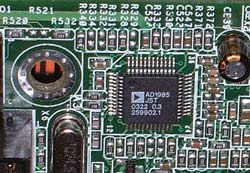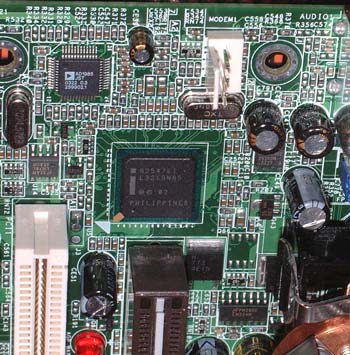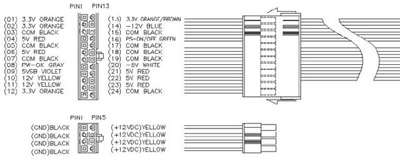Asus PC-DL Deluxe: 875 with Dual Xeons
by Wesley Fink on September 6, 2003 12:06 AM EST- Posted in
- Motherboards
Asus PC-DL: Basic Features
| Asus PC-DL Motherboard Specifications | |
| CPU Interface | Dual Xeon Socket-604 |
| Chipset | Intel 875P North Bridge Intel ICH5R South Bridge |
| Bus Speeds | 133 to 165 (in 1MHz increments) — 533FSB |
| Core Voltages Supported | Default only |
| AGP Voltages Supported | Default only |
| DRAM Voltages Supported | Default only |
| Chipset Voltage | Default only |
| CPU Multiplier Ratios | To 23X with 3.06 CPU |
| Memory Slots | 4 x 184-pin Dual-Channel DDR DIMM Slots Supports both Standard and ECC Memory to PC2700 (DDR333) |
| Expansion Slots | 1 AGP 8X Slot 5 PCI Slots |
| Onboard IDE RAID | Standard ATA 100/66 Supporting up to 4 IDE devices |
| Onboard USB 2.0/IEEE-1394 | 8 USB 2.0 ports supported by ICH5R 2 TI TSB43AB22A Firewire |
| Onboard LAN | Intel 82547EI CSA Gigabit LAN |
| Onboard Audio | ADI AD1985 6-channel |
| Onboard Serial ATA | Intel ICH5R supporting 2 SATA drives Promise PDC20378 for 2 SATA drives |
| Onboard RAID | Intel ICH5R SATA RAID 0,1 Promise 20378 SATA & IDE RAID 0,1, 0+1 |
| BIOS Revision | Release BIOS 1002 |

The feature list certainly looks more like a top-end consumer motherboard than a server board. In fact, the features are basically the same as the P4C800-E that we recently reviewed.

Asus has used the ADI 5.1 audio codec that has become standard on most of their recent boards. ADI is the same codec used by Intel on their 875 boards, and provides automatic switching of sound inputs. In addition, Asus has included a bracket with both coaxial and optical SPDIF out for connection to digital receivers or powered speakers. This is certainly not the kind of on-board audio you would normally expect to find on a Dual processor board.

On-board LAN is provided by Intel’s Gigabit LAN chip providing LAN support on the dedicated CSA bus.

4 USB 2.0 ports are included on the I/O panel with headers for 4 additional USB 2 ports on the motherboard, for a total of 8 USB 2.0 ports provided by the Intel ICH5R South Bridge. Asus provides an accessory bracket with 2 USB ports and a game port. 2 IEEE1384 Firewire ports are available, with one on the I/O panel and one provided on an included accessory bracket.

Serial ATA support is available from both the ICH5R South Bridge and the Promise 20378 controller. Up to 4 individual SATA drives or various combinations of Intel and/or Promise RAID are available. In addition, Asus provides an additional Promise IDE connector that supports up to 2 single drives or 2 ATA133 IDE drives in a RAID configuration. Asus includes four SATA cables, and the 2 sets of power splitters/adapters to allow convenient connection of up to 4 Serial ATA drives.

The Asus PC-DL provides standard IO options on the back panel, plus a firewire port, Gigabit LAN port, and 4 USB 2.0 connectors. A dedicated IO backplate is included. The mini jacks appear to be the standard line-in/line out/mic jacks, but in fact, they automatically configure themselves depending on what you plug into the jacks.
To this point, we could be talking about features on the P4C800-E, but there are several features that immediately tell you this is a Dual Xeon board.
While the PC-DL is a standard ATX configuration and fits the same cases as regular single-processor boards, you will still need a workstation/server power supply. The standard ATX power connector is 20-pin with a 4-pin 12V connector. The PC-DL requires a 24-pin power connection and the 8-pin connector only available on Xeon power supplies.
Click to enlarge.
Fortunately, there are several commonly available power supplies that will meet the requirements. The Vantec Aluminum Stealth 470W and 520W power supplies come with a 24-pin power connector plus a converter for standard 20-pin ATX. Also included are both the standard 4-pin 12V and the 8-pin connector required for Dual-Processor/Server boards like the PC-DL. In addition, both Enermax and Antec have Xeon-style power supplies available at about $50 more than a standard ATX power supply. We do like the Vantec feature of being able to use their power supply for both regular ATX boards and Xeon boards.
Early information about the PC-DL talks about the overclocking capabilities of the board. While the promise is certainly here, the current talk is overly ambitious in our opinion. The only overclocking adjustments on the current board/BIOS combination are FSB adjustment from 133 to 165 and the ability to use a lower multiplier with 3.06 Xeons. Without PCI/AGP lock and any voltage controls at all, even these features are of limited value. When we compare the components used on the PC-DL to those on top P4 boards, it is clear that Asus can provide more of these overclocking features with BIOS updates in the future. However, as it is currently shipping, any claims you see about overclocking are from those accustomed to seeing no overclocking controls at all on a Xeon board. Compared to a standard high-end Pentium 4 board, overclocking options are very limited.











29 Comments
View All Comments
Anonymous User - Saturday, September 6, 2003 - link
This review makes, me wonder...is it possible to use two P4 2400/800 CPU's on this board, maybe with some kind of adapter. Those P4's would likely outperform this Xeon setup and possibly also the Opteron, with a very interesting price tag, even if these adaptors would cost $50 each.And if anyone should see an Intel engineer, just tell him we want a 1000 MHZ FSB for those Xeons, as the i875 would surely pass all validation test at this speed, and the PC4000 memory is already available.
Wesley Fink - Saturday, September 6, 2003 - link
The 3200+ Athlon we use for testing AMD IS a Barton core. The 3.0 is the Intel CPU we have been using for benchmarking Intel.Anonymous User - Saturday, September 6, 2003 - link
Why not just make a dual 800FSB P4 system. With HT activated you'd get 4 virtual processors, something that XP Pro can handle.Anonymous User - Saturday, September 6, 2003 - link
i see commens like like its they use thw 3.2Hz p4 but what performance they all expect? 80% from 3.0 to 3.2Ghz?>Lonyo - Saturday, September 6, 2003 - link
"we are reviewing the PC-DL, and comparing it to the performance from the current top Pentium 4, Barton, and Opteron/Athlon64 boards that we have tested"Performance Test Configuration
Processor(s): Intel Dual Xeon 3.06 (1 Mb Cache) 533FSB
AMD Opteron Socket 940 at 2.0GHz (9x222) 444FSB
Intel Pentium 4 at 3.0GHz (800FSB)
No Barton in there, the top Opteron (or so I thought) was the 1.8GHz, and the top P4 is the 3.2 as far as I'm aware.
Anonymous User - Saturday, September 6, 2003 - link
Dual Xeons is a joke. The P4 is starved for bandwidth in a SINGLE processor configuration at 533Mhz FSB. What makes anyone think TWO processors can handle being that starved? It's like eating spaghetti through a straw -- you can get a few noodles, but it's faster to go buy a fork. And, last I heard, Intel wasn't planning on bring a 800Mhz FSB to the Xeon, just a stopgap 667Mhz FSB. Almost any task can be performed better by a single P4 3.0Ghz processor then dual Xeons of any speed on any platform. Xeons make no sense as a consumer platform all. And, with Opteron here, they make no sense as a server platform, either.When can I see my Athlon64 vs. Pentium 4 benchies? I hardly think an overclocked Opteron counts. After all, the 2.0Ghz Athlon64 isn't going to run with dual-channel memory, anyway. Can you say Socket 754? Luckily, AMD is already moving to Socket 940/939 for future releases. Mmm. 64-bit goodness.
Anonymous User - Saturday, September 6, 2003 - link
I'm always dissapointed in dual cpu system reviews, as they never show how the systems multitask. I would like to see the FPS in UT3 while encoding a movie at the same time. Can you play games while burning a DVD? I would like to see the performance while performing multiple tasks at the same time.Anonymous User - Saturday, September 6, 2003 - link
Yea, I'll bet Intel thought they could Spin dual Xeons as a viable filler until Prescott arrives some day. Reality shows there is no way the P4 or dual-Xeons are gonna hold a candle to a single Opteron/A64 let alone a dual system. Intel is hurting as their 90 nano stuff is gonna be too little, too late, and the suckers draw a pile of current = a ton of heat. Who wants that in a system thats' too expensive and that under performs??? They should just scrap the Prescott and work on something worth releasing to the market before it's obsolete.Anonymous User - Saturday, September 6, 2003 - link
Somehow this review looks eerily familiar. Hrm, wonder why :P.